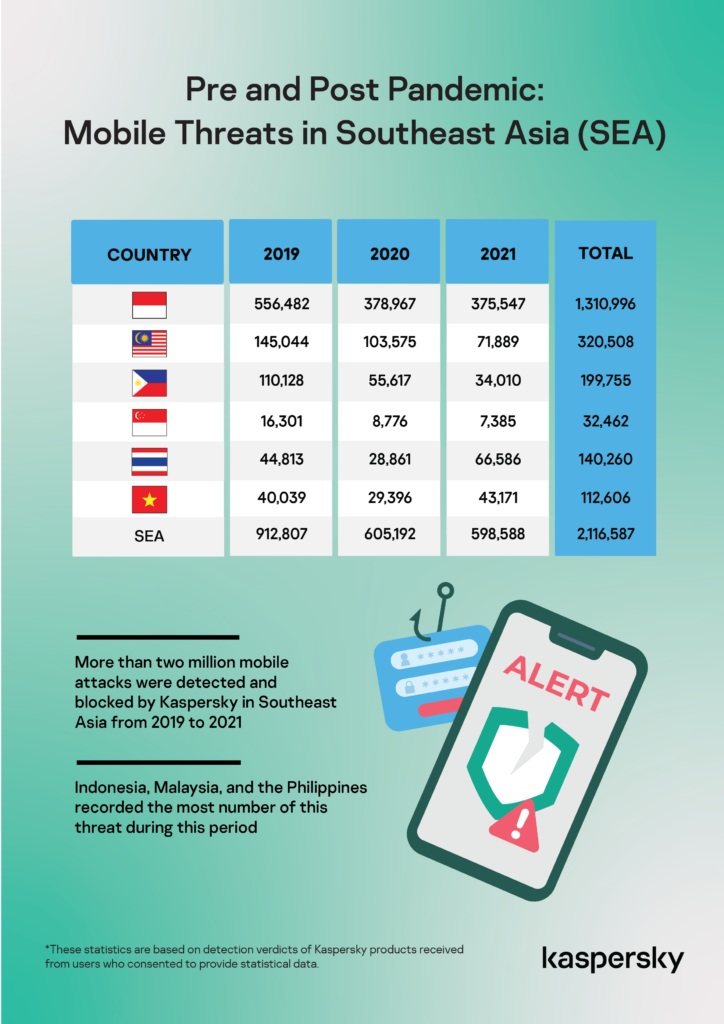Despite a decrease in the number of attacks, users should not be letting their guard down, Kaspersky warns. mobile malware
Globally, the number of mobile malware attacks have been falling gradually from a peak of 6.49 million in October 2020 to a low of 2.23 million in December 2021, based on detection verdicts of Kaspersky products received from users worldwide.
Mirroring this global trend, South-east Asian nations – primarily Indonesia, Malaysia, Philippines, Thailand, Vietnam and Singapore – collectively saw a decrease in mobile malware attacks from 605,192 in 2020 to 598,588 in 2021, representing a 1.1% decline as Kaspersky data revealed.
As its name suggests, mobile malware is a malicious software that specifically targets the operating systems of mobile devices such as smartphones and tablets.
However, despite a decrease in the number of attacks, users should not be letting their guard down considering that attacks are becoming more sophisticated in terms of both malware functionality and vectors.
“The future is definitely mobile here in South-east Asia. At the surface, it may seem that cybercriminals are becoming less active because of the decreased mobile malware attacks. But it is a global trend and it does not necessarily mean we are safer,” said Yeo Siang Tiong, General Manager for Southeast Asia at Kaspersky.
“We have to note that as we embrace digital payment apps more, we unconsciously put more of our hard-earned money in our devices. Our devices which usually remain vulnerable from simple malware attacks. There is a gap between awareness and action here in Southeast Asia so I urge digital payment providers and regulators to help us in encouraging users to protect their mobile devices too,” he added.

Malicious code injected into apps
Globally, 2021 saw repeat incidents of malicious code injection into popular apps through ad SDKs, as in the sensational case of CamScanner — where Kaspersky found malicious code inside ad libraries in the official APKPure client, as well as in a modified WhatsApp build.
Experts also continued to find malware in apps on Google Play, despite Google’s efforts to keep threats off the platform. Especially notable in 2021 were the Joker Trojan, which signs victims up to paid subscriptions, and the Facestealer Trojan, which steals credentials from Facebook accounts, and various banking Trojan loaders.
Besides apps with actual malicious functionality, there are various scamming apps on Google Play — for example, ones that imitate services where you can apply for welfare payments and redirect the user to a page asking for their data and payment of a fee.
For the fifth year in a row, Iran topped the leaderboard by share of infections: 40.2% of users there encountered mobile threats. As in the previous year, this was largely due to the active distribution of adware from the AdWare.AndroidOS.Notifyer family.
In second place is China (28.9%), where users most often crossed paths with potentially unwanted apps from the RiskTool.AndroidOS.Wapron family. Members of this family target victims’ mobile accounts, in particular by sending chargeable text messages on behalf of the victim as payment for supposedly viewing porn.
Not far behind in third place lies Saudi Arabia (28%), where users most often came across adware from the AdWare.AndroidOS.HiddenAd family.
Click here to access the full report.
Tips for protecting mobile devices
Cybercriminals are resourceful and take every opportunity to prey on mobile device users. So, regardless of their activity level, it pays to be alert.
- Download apps only from official sources. True, this is not a 100% security guarantee, but there are far less malicious programs in official stores, and even when malware slips through moderation it usually gets removed from the store relatively quickly.
- Whenever possible, use apps from trusted developers with a good reputation to minimize the chances of encountering malware.
- Ignore apps that promise payouts you’ve never heard of or overly generous prizes. It’s almost bound to be a scam.
- Don’t give apps permissions they don’t need to work. Most malware will not be able to deploy fully without potentially dangerous permissions, for example, access to Accessibility, access to text messages and installation of unknown apps.
- Use a reliable mobile antivirus that will detect and block malware that tries to get inside your phone.

















